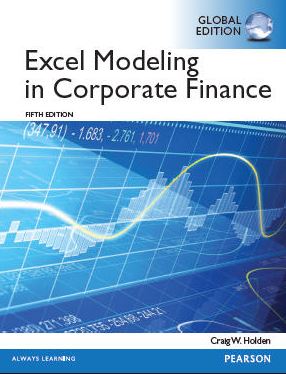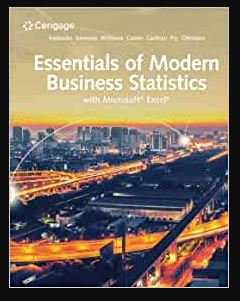Excel Modeling in Corporate Finance 5th GLOBAL Edition by Craig W. Holden, ISBN-13: 978-1292059389
[PDF eBook eTextbook]
230 pages
Publisher: Pearson Education Limited; 5th ed of revised global edition
Language: English
ISBN-10: 1292059389
ISBN-13: 978-1292059389
For courses in corporate finance or financial management at the undergraduate and graduate level.
Excel Modeling in Corporate Finance approaches building and estimating models with Microsoft Excel. Students are shown the steps involved in building models, rather than already-completed spreadsheets.
Table of contents:
Preface Fifth Edition Changes Ready-To-Build Spreadsheets What Is Unique About This Book Conventions Used In This BookCraig’s Challenge Excel (R) Modeling Books Suggestions for Faculty Members Acknowledgements About The Author PART 1 TIME VALUE OF MONEYChapter 1 Single Cash Flow 1.1 Present Value1.2 Future Value Problems Chapter 2 Annuity2.1 Present Value 2.2 Future Value2.3 System of Four Annuity Variables Problems Chapter 3 NPV Using Constant Discounting 3.1 Nominal Rate 3.2 Real Rate ProblemsChapter 4 NPV Using General Discounting4.1 Nominal Rate4.2 Real Rate Problems Chapter 5 Loan Amortization5.1 Basics 5.2 Sensitivity Analysis Problems Chapter 6 Lease Vs. Buy 6.1 Car6.2 Corporate Problems PART 2 VALUATIONChapter 7 Bond Valuation 7.1 Annual Payments7.2 EAR, APR, and Foreign Currencies 7.3 Duration and Convexity 7.4 Price Sensitivity7.5 System of Five Bond VariablesProblems Chapter 8 Estimating the Cost of Capital 8.1 Static CAPM Using Fama-MacBeth Method 8.2 APT or Intertemporal CAPM Using Fama-McBeth Method Problems Chapter 9 Stock Valuation 9.1 Dividend Discount Model Problems Chapter 10 Firm and Project Valuation 10.1 Cash Flows for Five Equivalent Methods 10.2 Adjusted Present Value 10.3 Free Cash Flow To Equity 10.4 Free Cash Flow to the Firm 10.5 Dividend Discount Model 10.6 Residual Income 10.7 Five Equivalent Methods Problems Appendix: Reconciling the Residual Income Method with Other Approaches to Valuing Firms or Projects Chapter 11 The Yield Curve11.1 Obtaining It From Treasury Bills and Strips 11.2 Using It To Price A Coupon Bond 11.3 Using It To Determine Forward Rates Problems Chapter 12 US Yield Curve Dynamics 12.1 Dynamic Chart Problems PART 3 CAPITAL STRUCTURE Chapter 13 Capital Structure13.1 Modigliani-Miller With No Taxes. 13.2 Modigliani-Miller With Corporate Taxes 13.3 Trade-off Model: Tax Shield vs. Distress Cost Problems PART 4 CAPITAL BUDGETING Chapter 14 Project NPV 14.1 Basics 14.2 Forecasting Cash Flows 14.3 Working Capital 14.4 Sensitivity Analysis Problems Chapter 15 Cost-Reducing Project 15.1 Basics 15.2 Sensitivity Analysis Problems Chapter 16 Break-Even Analysis 16.1 Based On Accounting Profit 16.2 Based On NPV Problems PART 5 FINANCIAL PLANNING Chapter 17 Corporate Financial Planning 17.1 Actual17.2 Forecast 17.3 Cash Flow 17.4 Ratios 17.5 Sensitivity 17.6 Full-Scale Estimation Problems Chapter 18 Du Pont System Of Ratio Analysis 18.1 Basics Problems Chapter 19 Life-Cycle Financial Planning 19.1 Taxable Vs. Traditional Vs. Roth Savings 19.2 Basic Life-Cycle Planning 19.3 Full-Scale Life-Cycle Planning Problems PART 6 INTERNATIONAL CORPORATE FINANCE Chapter 20 International Parity 20.1 System of Four Parity Conditions 20.2 Estimating Future Exchange Rates Problems PART 7 OPTIONS AND CORPORATE FINANCE Chapter 21 Binomial Option Pricing 21.1 Estimating Volatility 21.2 Single Period 21.3 Multi-Period 21.4 Risk Neutral 21.5 Average of N and N-121.6 Convergence to Normal 21.7 American With Discrete Dividends 21.8 Full-Scale ProblemsChapter 22 Real Options 22.1 Option To Abandon22.2 Option to Expand22.3 Option to Contract 22.4 Option To Choose 22.5 Compound Option Problems Chapter 23 Black-Scholes Option Pricing 23.1 Basics 23.2 Continuous Dividend 23.3 Implied VolatilityProblems Chapter 24 Debt And Equity Valuation 24.1 Two Methods 24.2 Impact of Risk Problems PART 8 EXCEL SKILLS Chapter 25 Useful Excel Tricks 25.1 Quickly Delete The Instructions and Arrows 25.2 Freeze Panes 25.3 Spin Buttons and the Developer Tab 25.4 Option Buttons and Group Boxes 25.5 Scroll Bar 25.6 Install Solver or the Analysis ToolPak 25.7 Format Painter 25.8 Conditional Formatting 25.9 Fill Handle 25.10 2-D Scatter Chart 25.11 3-D Surface Chart DOWNLOADABLE CONTENTSExcel Modeling in Corporate Finance Fourth Edition.pdfReady-To-Build spreadsheets available in both XLSX and XLS file formats:Ch 01 Single Cash Flow – Ready-To-Build.xlsxCh 02 Annuity – Ready-To-Build.xlsx Ch 03 NPV Using Constant Discounting – Ready-To-Build.xlsxCh 04 NPV Using General Discounting – Ready-To-Build.xlsx Ch 05 Loan Amortization – Ready-To-Build.xlsx Ch 06 Lease Vs Buy – Ready-To-Build.xlsx Ch 07 Bond Valuation – Ready-To-Build.xlsx Ch 08 Estimating the Cost of Capital – Ready-To-Build.xlsx Ch 09 Stock Valuation – Ready-To-Build.xlsx Ch 10 Firm and Project Valuation – Ready-To-Build.xlsx Ch 11 The Yield Curve – Ready-To-Build.xlsx Ch 12 US Yield Curve Dynamics – Ready-To-Build.xlsx Ch 13 Capital Structure – Ready-To-Build.xlsx Ch 14 Project NPV – Ready-To-Build.xlsx Ch 15 Cost-Reducing Project – Ready-To-Build.xlsx Ch 16 Break-Even Analysis – Ready-To-Build.xlsxCh 17 Corporate Financial Planning – Ready-To-Build.xlsx Ch 18 Du Pont System of Ratio Analysis – Ready-To-Build.xlsx Ch 19 Life-Cycle Financial Planning – Ready-To-Build.xlsx Ch 20 International Parity – Ready-To-Build.xlsxCh 21 Binomial Option Pricing – Ready-To-Build.xlsx Ch 22 Real Options – Ready-To-Build.xlsxCh 23 Black-Scholes Option Pricing – Ready-To-Build.xlsx Ch 24 Debt and Equity Valuation – Ready-To-Build.xlsx
What makes us different?
• Instant Download
• Always Competitive Pricing
• 100% Privacy
• FREE Sample Available
• 24-7 LIVE Customer Support









Reviews
There are no reviews yet.